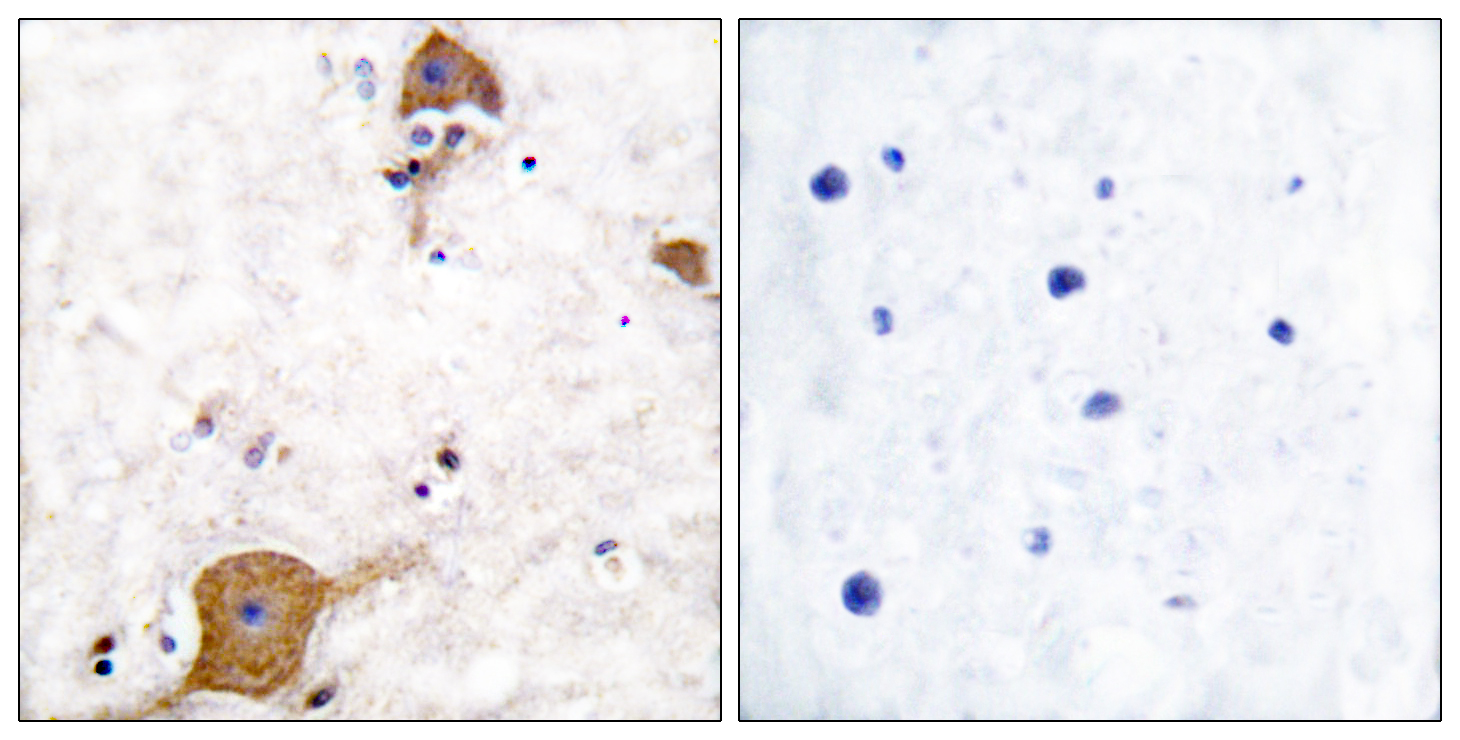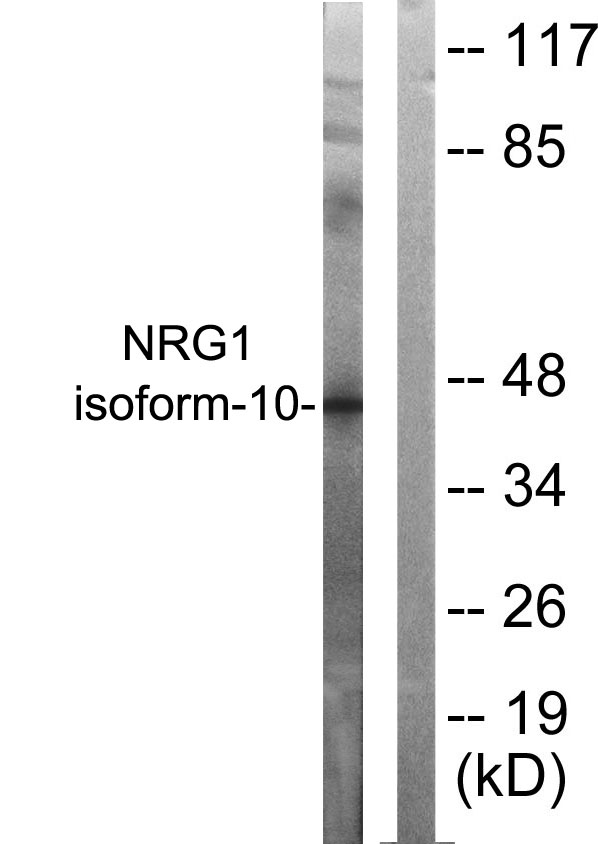Neuregulin-1 SMDF Polyclonal Antibody
- Catalog No.:YT3054
- Applications:WB;IHC;IF;ELISA
- Reactivity:Human;Mouse;Rat
- Target:
- Neuregulin-1
- Fields:
- >>EGFR tyrosine kinase inhibitor resistance;>>ErbB signaling pathway;>>Amyotrophic lateral sclerosis
- Gene Name:
- NRG1
- Protein Name:
- Pro-neuregulin-1 membrane-bound isoform
- Human Gene Id:
- 3084
- Human Swiss Prot No:
- Q02297-10
- Immunogen:
- The antiserum was produced against synthesized peptide derived from human NRG1 isoform-10. AA range:1-50
- Specificity:
- Neuregulin-1 SMDF Polyclonal Antibody detects endogenous levels of Neuregulin-1 SMDF protein.
- Formulation:
- Liquid in PBS containing 50% glycerol, 0.5% BSA and 0.02% sodium azide.
- Source:
- Polyclonal, Rabbit,IgG
- Dilution:
- WB 1:500 - 1:2000. IHC 1:100 - 1:300. IF 1:200 - 1:1000. ELISA: 1:10000. Not yet tested in other applications.
- Purification:
- The antibody was affinity-purified from rabbit antiserum by affinity-chromatography using epitope-specific immunogen.
- Concentration:
- 1 mg/ml
- Storage Stability:
- -15°C to -25°C/1 year(Do not lower than -25°C)
- Other Name:
- Pro-neuregulin-1 membrane-bound isoform;Pro-NRG1;NRG1;GGF;HGL;HRGA;NDF;SMDF
- Observed Band(KD):
- 44kD
- Background:
- The protein encoded by this gene is a membrane glycoprotein that mediates cell-cell signaling and plays a critical role in the growth and development of multiple organ systems. An extraordinary variety of different isoforms are produced from this gene through alternative promoter usage and splicing. These isoforms are expressed in a tissue-specific manner and differ significantly in their structure, and are classified as types I, II, III, IV, V and VI. Dysregulation of this gene has been linked to diseases such as cancer, schizophrenia, and bipolar disorder (BPD). [provided by RefSeq, Apr 2016],
- Function:
- alternative products:Additional isoforms seem to exist. Isoforms have been classified as type I NRGs (isoforms with an Ig domain and a glycosylation domain, isoforms 1-8), type II NRGs (isoforms with an Ig domain but no glycosylation domain, isoform 9) and type III NRGs (isoforms with a Cys-rich domain, isoform 10). All these isoforms perform distinct tissue-specific functions,developmental stage:Detectable at early embryonic ages.,disease:A rare chromosomal aberration involving NRG1 produces gamma-heregulin. Translocation t(8;11) with ODZ4. The translocation fuses the 5'-end of ODZ4 to NRG1 (isoform 8). The product of this translocation was first thought to be an alternatively spliced isoform. Gamma-heregulin is a soluble activating ligand for the ERBB2-ERBB3 receptor complex and acts as an autocrine growth factor in a specific breast cancer cell line (MDA-MB-175). Not detected in breas
- Subcellular Location:
- [Pro-neuregulin-1, membrane-bound isoform]: Cell membrane; Single-pass type I membrane protein. Does not seem to be active.; [Neuregulin-1]: Secreted.; [Isoform 8]: Nucleus. May be nuclear.; [Isoform 9]: Secreted. Has a signal peptide.; [Isoform 10]: Membrane; Single-pass type I membrane protein. May possess an internal uncleaved signal sequence.
- Expression:
- Type I isoforms are the predominant forms expressed in the endocardium. Isoform alpha is expressed in breast, ovary, testis, prostate, heart, skeletal muscle, lung, placenta liver, kidney, salivary gland, small intestine and brain, but not in uterus, stomach, pancreas, and spleen. Isoform 3 is the predominant form in mesenchymal cells and in non-neuronal organs, whereas isoform 6 is the major neuronal form. Isoform 8 is expressed in spinal cord and brain. Isoform 9 is the major form in skeletal muscle cells; in the nervous system it is expressed in spinal cord and brain. Also detected in adult heart, placenta, lung, liver, kidney, and pancreas. Isoform 10 is expressed in nervous system: spinal cord motor neurons, dorsal root ganglion neurons, and brain. Predominant isoform expressed in sen
- June 19-2018
- WESTERN IMMUNOBLOTTING PROTOCOL
- June 19-2018
- IMMUNOHISTOCHEMISTRY-PARAFFIN PROTOCOL
- June 19-2018
- IMMUNOFLUORESCENCE PROTOCOL
- September 08-2020
- FLOW-CYTOMEYRT-PROTOCOL
- May 20-2022
- Cell-Based ELISA│解您多样本WB检测之困扰
- July 13-2018
- CELL-BASED-ELISA-PROTOCOL-FOR-ACETYL-PROTEIN
- July 13-2018
- CELL-BASED-ELISA-PROTOCOL-FOR-PHOSPHO-PROTEIN
- July 13-2018
- Antibody-FAQs
- Products Images

- Immunohistochemistry analysis of paraffin-embedded human brain tissue, using NRG1 isoform-10 Antibody. The picture on the right is blocked with the synthesized peptide.

- Western blot analysis of lysates from SKOV3 cells, using NRG1 isoform-10 Antibody. The lane on the right is blocked with the synthesized peptide.



